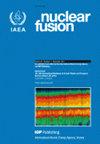MHD flows through ferromagnetic rectangular ducts in liquid metal blankets
IF 4
1区 物理与天体物理
Q1 PHYSICS, FLUIDS & PLASMAS
引用次数: 0
Abstract
In most designs of liquid metal blankets, the reduced activation ferritic martensitic steel with high relative magnetic permeability is proposed as the structural wall material, which will have an obvious influence on the magnetic field distribution inside the duct and consequently modify the liquid metal magnetohydrodynamics (MHD) flow state. However, the MHD flow state considering the influence of the ferromagnetic wall is lack of systematic investigations especially under the relevant conditions of magnetic confinement fusion reactors. In this work, systematic investigations on the ferromagnetic MHD effect are conducted by experiments and numerical simulations considering the relevant condition of fusion reactors such as high magnetic fields up to 10 T and the actual magnetic permeability of ferromagnetic walls. It is found that magnetic field lines are mainly gathered through the side wall for ferromagnetic rectangular ducts, which will result in the overall magnetic shielding effect. As applied magnetic fields increase, the magnetic shielding effect weakens, increasing the aspect ratio and wall thickness of the duct is benefit to enhance the overall magnetic shielding effect. A slightly magnetic strengthening effect is firstly observed in our experimental and numerical investigations, which is characterized that the average magnetic flux intensity in the fluid region is slightly greater than applied magnetic fields and the pressure drop in ferromagnetic ducts is also higher than that in non-ferromagnetic ducts when the applied magnetic field is bigger than the threshold of transition. The dimensionless pressure gradient in ferromagnetic rectangular ducts usually increases firstly and then decreases with the increase of applied magnetic fields, the pressure drop estimated from the coefficient of the square of the average magnetic flux intensity in the fluid region is generally accurate with exceptions in some extreme conditions. These findings will provide a theoretical guidance for future liquid metal blanket designs.流经液态金属毯中铁磁矩形导管的 MHD 气流
在大多数液态金属毯的设计中,具有高相对磁导率的还原活化铁素体马氏体钢被建议作为结构壁材料,这将对管道内的磁场分布产生明显影响,并进而改变液态金属磁流体力学(MHD)流态。然而,考虑到铁磁壁影响的 MHD 流动状态还缺乏系统研究,尤其是在磁约束聚变反应堆的相关条件下。在这项工作中,考虑到核聚变反应堆的相关条件,如高达 10 T 的磁场和铁磁壁的实际磁导率,通过实验和数值模拟对铁磁 MHD 效应进行了系统研究。研究发现,磁场线主要通过铁磁性矩形管道的侧壁聚集,从而产生整体磁屏蔽效应。随着外加磁场的增加,磁屏蔽效应减弱,增加风道的长宽比和壁厚有利于增强整体磁屏蔽效应。在我们的实验和数值研究中,首先观察到了轻微的磁强化效应,其特征是流体区域的平均磁通强度略大于外加磁场,当外加磁场大于过渡阈值时,铁磁性风道中的压降也高于非铁磁性风道中的压降。铁磁性矩形风道中的无量纲压力梯度通常随着外加磁场的增加而先增大后减小,根据流体区域平均磁通强度平方系数估算的压降基本准确,但在某些极端条件下例外。这些发现将为未来的液态金属毯设计提供理论指导。
本文章由计算机程序翻译,如有差异,请以英文原文为准。
求助全文
约1分钟内获得全文
求助全文
来源期刊

Nuclear Fusion
物理-物理:核物理
CiteScore
6.30
自引率
39.40%
发文量
411
审稿时长
2.6 months
期刊介绍:
Nuclear Fusion publishes articles making significant advances to the field of controlled thermonuclear fusion. The journal scope includes:
-the production, heating and confinement of high temperature plasmas;
-the physical properties of such plasmas;
-the experimental or theoretical methods of exploring or explaining them;
-fusion reactor physics;
-reactor concepts; and
-fusion technologies.
The journal has a dedicated Associate Editor for inertial confinement fusion.
 求助内容:
求助内容: 应助结果提醒方式:
应助结果提醒方式:


